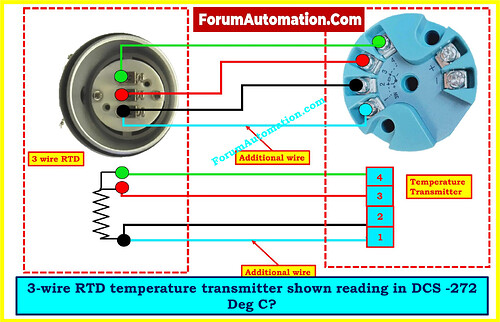3-wire RTD temperature transmitter shown reading in DCS -272 Deg C?
3-wire RTD temperature transmitter shown reading in DCS -272 Deg C?
A 3-wire RTD (Resistance Temperature Detector) temperature transmitter that shows -272°C in the DCS (Distributed Control System) usually means that there is a problem with the wiring or the sensor is open. The temperature of -272°C is quite low, almost reaching absolute zero (-273.15°C), which is not conceivable in real life. This isn’t an actual temperature; it’s a default error signal that many transmitters are set to send out when something goes wrong.
A 3-wire RTD setup uses three wires to make up for the resistance of the lead wire, which makes the measurement more accurate. If one of the wires breaks, gets detached, or shorts, though, the transmitter can’t detect resistance accurately anymore. When an RTD loop is open or the impedance is high, most transmitters are set to send out a low temperature value, such -200°C to -273°C.
These are the most important measures to take when troubleshooting:
- Use a multimeter to check the continuity of the wiring and make sure all three wires are connected correctly.
- Check the connections at the RTD and transmitter ends to make sure they aren’t loose or corroded.
- Make sure that the type of input the transmitter uses (such Pt100 or 3-wire) is the same as the sensor’s.
- If you can, briefly swap out the RTD with a working one to make sure the sensor is broken.
This kind of mistake is very important in process industries and needs to be fixed right away since it could affect the safety of the process, the accuracy of the control, and the management of alarms. Always check the transmitter handbook for the exact failure indication codes.
